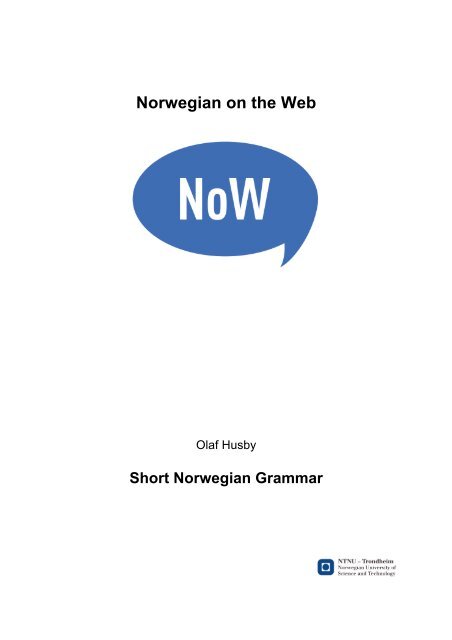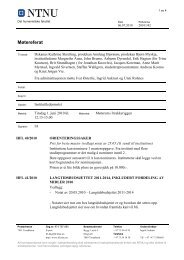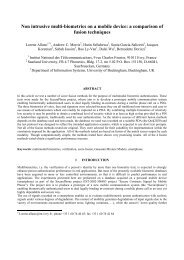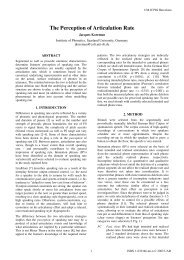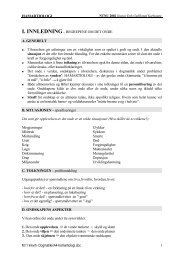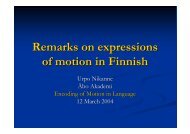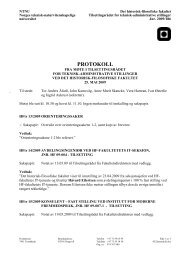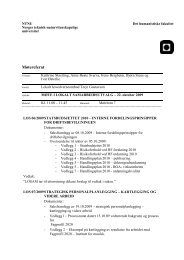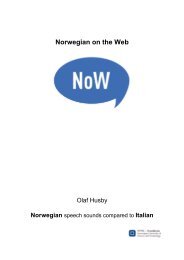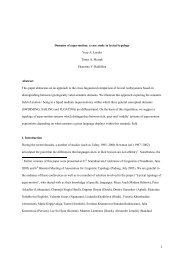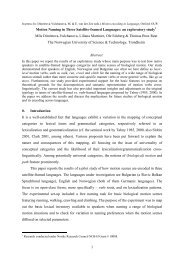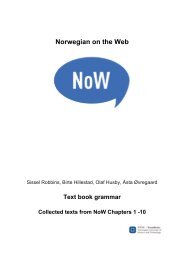Norwegian on the Web - Short grammar - NTNU
Norwegian on the Web - Short grammar - NTNU
Norwegian on the Web - Short grammar - NTNU
You also want an ePaper? Increase the reach of your titles
YUMPU automatically turns print PDFs into web optimized ePapers that Google loves.
<str<strong>on</strong>g>Norwegian</str<strong>on</strong>g> <strong>on</strong> <strong>the</strong> <strong>Web</strong><br />
<br />
<br />
<br />
Olaf Husby<br />
<strong>Short</strong> <str<strong>on</strong>g>Norwegian</str<strong>on</strong>g> Grammar
<str<strong>on</strong>g>Norwegian</str<strong>on</strong>g> <strong>on</strong> <strong>the</strong> <strong>Web</strong>, <strong>NTNU</strong> <strong>Short</strong> <strong>grammar</strong> 2<br />
C<strong>on</strong>tent<br />
Nouns .......................................................................................................................... 4<br />
General .................................................................................................................... 4<br />
Comm<strong>on</strong> nouns .................................................................................................... 4<br />
Proper nouns ........................................................................................................ 4<br />
Gender ................................................................................................................. 4<br />
C<strong>on</strong>jugati<strong>on</strong> of nouns ........................................................................................... 5<br />
The simple pattern ............................................................................................ 5<br />
System used in this course ............................................................................... 5<br />
Verbs ........................................................................................................................... 6<br />
Verbs - terminology .................................................................................................. 6<br />
Regular verbs ................................................................................................... 7<br />
Irregular verbs ................................................................................................... 7<br />
Tenses and forms ............................................................................................. 8<br />
Infinitive ................................................................................................................ 8<br />
Present ................................................................................................................. 8<br />
Preterite ................................................................................................................ 9<br />
Present perfect ..................................................................................................... 9<br />
Preterite perfect .................................................................................................... 9<br />
Present future ....................................................................................................... 9<br />
Preterite future .................................................................................................... 10<br />
Present future perfect ......................................................................................... 10<br />
Preterite future perfect ........................................................................................ 10<br />
Auxiliary verbs ........................................................................................................ 10<br />
Comm<strong>on</strong> auxiliary verbs ..................................................................................... 10<br />
Modal auxiliary verbs .......................................................................................... 11<br />
Adjectives .................................................................................................................. 12<br />
General .................................................................................................................. 12<br />
Agreement .......................................................................................................... 12<br />
Agreement: Attributive form ............................................................................ 12<br />
Agreement: Predicative form .......................................................................... 12<br />
Comparis<strong>on</strong> ........................................................................................................ 13<br />
Comparis<strong>on</strong> between two objects ...................................................................... 13<br />
Adverbs ..................................................................................................................... 14<br />
General .................................................................................................................. 14<br />
Adverbs – adverbial ............................................................................................... 14<br />
Modifying adjectives ....................................................................................... 14<br />
Adverbs - form ................................................................................................ 15<br />
Pr<strong>on</strong>ouns ................................................................................................................... 16<br />
General .................................................................................................................. 16<br />
Articles ....................................................................................................................... 18<br />
Dem<strong>on</strong>stratives .......................................................................................................... 19<br />
Determinatives ........................................................................................................... 21<br />
Possessives ........................................................................................................... 21
<str<strong>on</strong>g>Norwegian</str<strong>on</strong>g> <strong>on</strong> <strong>the</strong> <strong>Web</strong>, <strong>NTNU</strong> <strong>Short</strong> <strong>grammar</strong> 3<br />
Possessive expressi<strong>on</strong>s ..................................................................................... 22<br />
Quantifiers .............................................................................................................. 22<br />
Cardinal Numbers .............................................................................................. 22<br />
Ordinal Numbers ................................................................................................ 23<br />
Old an new counting system .............................................................................. 23<br />
Countable/uncountable amounts ........................................................................ 23<br />
Countable amounts ......................................................................................... 23<br />
Uncountable amounts ..................................................................................... 23<br />
Quantifiers with grammatical agreement ............................................................ 24<br />
Prepositi<strong>on</strong>s ............................................................................................................... 25<br />
C<strong>on</strong>juncti<strong>on</strong>s .............................................................................................................. 26<br />
Subjuncti<strong>on</strong>s .............................................................................................................. 27<br />
General .................................................................................................................. 27<br />
Nominal functi<strong>on</strong> ................................................................................................. 27<br />
Adverbial functi<strong>on</strong> ............................................................................................... 27<br />
Adjectival functi<strong>on</strong> .............................................................................................. 29<br />
Interjecti<strong>on</strong>s ............................................................................................................... 30<br />
General .................................................................................................................. 30<br />
Interjecti<strong>on</strong>s used for answers ............................................................................ 30<br />
Greetings ............................................................................................................ 30<br />
Sentences .................................................................................................................. 31<br />
Main clause ............................................................................................................ 31<br />
Subordinate clause ................................................................................................ 32<br />
As <strong>the</strong> text book <strong>grammar</strong> is lacking descripti<strong>on</strong>s of some word classes, we would<br />
like to present a short review of all word classes in <str<strong>on</strong>g>Norwegian</str<strong>on</strong>g>.
<str<strong>on</strong>g>Norwegian</str<strong>on</strong>g> <strong>on</strong> <strong>the</strong> <strong>Web</strong>, <strong>NTNU</strong> <strong>Short</strong> <strong>grammar</strong> 4<br />
Nouns <br />
General<br />
Nouns are words that name people, things, acti<strong>on</strong>s, places, states. Nouns are<br />
divided in two subgroups, comm<strong>on</strong> and proper nouns.<br />
Comm<strong>on</strong> nouns <br />
These are nouns that name general items. In <str<strong>on</strong>g>Norwegian</str<strong>on</strong>g> comm<strong>on</strong> nouns are written<br />
with lower-case letters (except when <strong>the</strong>y occur after a full stop): “student” (student),<br />
“universitet” (university), “idé” (idea).<br />
Proper nouns <br />
These are nouns that name a specific item, often a “<strong>on</strong>e-of-a-kind”. Proper nouns are<br />
written with upper-case letters: “Norge” (Norway), “Tr<strong>on</strong>dheim” (Tr<strong>on</strong>dheim), “Julie”<br />
(Julie).<br />
Gender <br />
In <str<strong>on</strong>g>Norwegian</str<strong>on</strong>g>, nouns are grouped into three categories according to <strong>the</strong> noun's<br />
gender (kjønn). This divisi<strong>on</strong> is important as nouns are c<strong>on</strong>jugated according to its<br />
inherent gender.<br />
Gender <str<strong>on</strong>g>Norwegian</str<strong>on</strong>g> term Literal translati<strong>on</strong><br />
masculine hankjønn “he-gender”<br />
feminine hunkjønn “she-gender”<br />
neuter intetkjønn “no-gender”<br />
In most cases <strong>the</strong> assignment of gender is arbitrary, and for learners of <str<strong>on</strong>g>Norwegian</str<strong>on</strong>g> it<br />
usually is difficult to guess <strong>the</strong> gender of a given noun.<br />
In general <strong>on</strong>e may say that<br />
• about 50 per cent of all nouns are of masculine gender<br />
• about 25 per cent of all nouns are of feminine gender<br />
• about 25 per cent of all nouns are of neuter gender<br />
However, as all feminine nouns may be c<strong>on</strong>jugated as masculine nouns, 75 per cent<br />
of all nouns may use articles for masculine nouns, and 25 per cent as articles for<br />
neuter nouns.
<str<strong>on</strong>g>Norwegian</str<strong>on</strong>g> <strong>on</strong> <strong>the</strong> <strong>Web</strong>, <strong>NTNU</strong> <strong>Short</strong> <strong>grammar</strong> 5<br />
C<strong>on</strong>jugati<strong>on</strong> of nouns <br />
The noun is an independent form in singular indefinite. Adding a suffix to <strong>the</strong> end of<br />
<strong>the</strong> noun makes definite form singular. Indefinite and definite form plural are made<br />
<strong>the</strong> same way. The suffixes are listed below. The three dots are replacing any<br />
noun.<br />
Two c<strong>on</strong>jugati<strong>on</strong> patterns are presented below. First you find <strong>the</strong> very basic rules.<br />
The simple pattern<br />
Singular<br />
Plural<br />
Indefinite Definite Indefinite Definite<br />
masculine en … …-en<br />
…-er<br />
feminine ei … …-a<br />
…-ene<br />
neuter et … …-et …-<br />
System used in this course<br />
As <strong>the</strong>re are several excepti<strong>on</strong>s, this extended versi<strong>on</strong> is presented. These patterns<br />
will cover most cases in this introductory course.<br />
Singular<br />
Plural<br />
Indefinite Definite Indefinite Definite<br />
masculine en … …-(e)n …-(e)r …-(e)ne<br />
feminine ei … …-a …-(e)r …-(e)ne<br />
neuter et … …-(e)t … - …-(e)ne<br />
…-(e)r
<str<strong>on</strong>g>Norwegian</str<strong>on</strong>g> <strong>on</strong> <strong>the</strong> <strong>Web</strong>, <strong>NTNU</strong> <strong>Short</strong> <strong>grammar</strong> 6<br />
Verbs <br />
Verbs are words that name what is going <strong>on</strong> (acti<strong>on</strong>s, states of being, what exists).<br />
<str<strong>on</strong>g>Norwegian</str<strong>on</strong>g> verbs occur in several forms as a result of c<strong>on</strong>jugati<strong>on</strong>. The different<br />
forms of a verb can be divided into<br />
- Finite forms, that is forms that express time (past, present) or mode<br />
- Infinite forms, that is forms that do not express time or mode<br />
As in English you will find both regular (“weak”) and irregular (“str<strong>on</strong>g”) verbs.<br />
- Regular verbs form preterite (past tense) by adding a suffix to <strong>the</strong> stem<br />
- Irregular verbs form preterite without adding a suffix to <strong>the</strong> stem<br />
<str<strong>on</strong>g>Norwegian</str<strong>on</strong>g> verbs are not c<strong>on</strong>jugated in pers<strong>on</strong> and number.<br />
Verbs - terminology<br />
In this presentati<strong>on</strong> <strong>the</strong> new standard terminology is used. The English translati<strong>on</strong> of<br />
<strong>the</strong> new an old terminology (Strandskogen 1995) is shown below. N<strong>on</strong>-overlapping<br />
categories are marked in grey.<br />
Strandskogen (1995) Grammatical terminology applied in teaching (2006)<br />
English<br />
<str<strong>on</strong>g>Norwegian</str<strong>on</strong>g><br />
Infinitive Infinitive Infinitiv<br />
Present Present Presens<br />
Past (Imperfect) Preterite Preteritum<br />
Perfect Present perfect Presens perfektum<br />
Pluperfect Preterite perfect Preteritum perfektum<br />
Future Present future Presens futurum<br />
Future perfect Preterite future Preteritum futurum<br />
C<strong>on</strong>diti<strong>on</strong>al Present future perfect Presens futurum perfektum<br />
C<strong>on</strong>diti<strong>on</strong>al perfect Preterite future perfect Preteritum futurum perfektum<br />
<str<strong>on</strong>g>Norwegian</str<strong>on</strong>g> verbs occur in seven different forms. This is dem<strong>on</strong>strated below using<br />
<strong>the</strong> regular “øke” - “increase” and <strong>the</strong> irregular verb “skrive” - “write”.<br />
Verb form Structure <str<strong>on</strong>g>Norwegian</str<strong>on</strong>g> English<br />
Imperative stem øk increase<br />
Infinitive stem + “-e” øke increase<br />
Present stem + “-er” øker increase(s)<br />
Preterite stem + ending “-te” økte increased<br />
Perfect participle stem + ending “-t” økt increased<br />
Present participle stem + “-ende” økende increasing<br />
Passive voice stem + “-es” økes is being increased
<str<strong>on</strong>g>Norwegian</str<strong>on</strong>g> <strong>on</strong> <strong>the</strong> <strong>Web</strong>, <strong>NTNU</strong> <strong>Short</strong> <strong>grammar</strong> 7<br />
Verb form Structure <str<strong>on</strong>g>Norwegian</str<strong>on</strong>g> English<br />
Imperative stem skriv write<br />
Infinitive stem + “-e” skrive write<br />
Present stem + “-er” skriver write(s)<br />
Preterite internal change skrev wrote<br />
Perfect participle internal change skrevet written<br />
Present participle stem + “-ende” skrivende writing<br />
Passive voice stem + “-es” skrives is being written<br />
The verb forms above occur for both regular and irregular verbs. However, <strong>the</strong>y are<br />
produced in slightly different ways. Regular verbs produce preterite and present<br />
perfect forms by adding a suffix to <strong>the</strong> verb. Irregular verbs produce preterite by<br />
changing <strong>the</strong> stem vowel. The present perfect participle of irregular verbs in general<br />
ends in a “-t”.<br />
The present participle form is <strong>the</strong> adjectival form of <strong>the</strong> verb, and is used <strong>on</strong>ly as<br />
adjective or adverb, not as verb.<br />
et økende antall<br />
et gråtende barn<br />
an increasing number<br />
a crying child<br />
Regular verbs<br />
There are four classes of regular verbs. 1. class has two patterns. The “-et”-form is<br />
regarded as more formal than <strong>the</strong> “-a”-form.<br />
Infinitive Present Preterite Present English<br />
perfect<br />
1. class å kaste -er<br />
-et<br />
-et<br />
-a -a<br />
to throw<br />
2. class å leke -er -te -t to play<br />
3. class å leve -er -de -d to live<br />
4. class å nå -r -dde -dd to reach<br />
Irregular verbs<br />
Irregular verbs produce preterite by changing <strong>the</strong> stem vowel. The present perfect<br />
participle in general ends in a “-t”. Irregular verbs are quite heterogeneous.<br />
Infinitive Present Preterite Present perfect English<br />
å skrive skriver skrev har skrevet to write<br />
å finne finner fant har funnet to find<br />
å vinne vinner vant har vunnet to win
<str<strong>on</strong>g>Norwegian</str<strong>on</strong>g> <strong>on</strong> <strong>the</strong> <strong>Web</strong>, <strong>NTNU</strong> <strong>Short</strong> <strong>grammar</strong> 8<br />
Tenses and forms<br />
Below all forms and tenses of verbs are dem<strong>on</strong>strated using <strong>the</strong> regular verb “øke” -<br />
“increase” (PP = present participle, INF = infinitive)<br />
Form <str<strong>on</strong>g>Norwegian</str<strong>on</strong>g> Example English<br />
Imperative øk stem increase!<br />
Infinitive øke stem + “-e” increase<br />
Present øker stem + “-er” increase<br />
Preterite økte stem + ending increased<br />
Present perfect har økt har + PP have increased<br />
Preterite perfect hadde økt hadde + PP had increased<br />
Present future vil øke vil + INF will increase<br />
Preterite future ville øke ville + INF would increase<br />
Present future perfect vil ha økt vil ha + PP will have increased<br />
Preterite future perfect ville ha økt ville ha + PP would have increased<br />
Infinitive <br />
The infinitive form is <strong>the</strong> base form of <strong>the</strong> verb. This form is used toge<strong>the</strong>r with<br />
auxiliary verbs to make complex verb forms. With auxiliary verbs <strong>the</strong> infinitive marker<br />
“å” (to) is not used.<br />
å synge<br />
Jeg liker å synge<br />
Jeg kan synge<br />
to sing<br />
I like to sing<br />
I can sing<br />
Present <br />
Present tense may express present acti<strong>on</strong>s, general statements that are independent<br />
of time and place, and repeated acti<strong>on</strong>s.<br />
Jeg leser nå.<br />
To pluss to er fire.<br />
Jeg legger meg alltid klokka 11<br />
I am reading now.<br />
Two plus two is four.<br />
I always go to bed at 11 o’clock.<br />
Present tense forms of verbs may also be used in statements related to <strong>the</strong> future,<br />
quite often in c<strong>on</strong>necti<strong>on</strong> with time phrases that are referring to <strong>the</strong> future:<br />
De kommer i morgen.<br />
They are coming tomorrow.
<str<strong>on</strong>g>Norwegian</str<strong>on</strong>g> <strong>on</strong> <strong>the</strong> <strong>Web</strong>, <strong>NTNU</strong> <strong>Short</strong> <strong>grammar</strong> 9<br />
Preterite <br />
In general <strong>on</strong>e can say that this verb form is used to express acti<strong>on</strong>s that took part at<br />
a definite point of time in <strong>the</strong> past. The focus is <strong>on</strong> <strong>the</strong> acti<strong>on</strong> itself.<br />
Jeg spiste frokost klokka 10.<br />
I had breakfast at 10 o’clock.<br />
Present perfect <br />
In general <strong>on</strong>e can say that this verb form is used to express acti<strong>on</strong>s that took part in<br />
<strong>the</strong> past, but without referring to a definite point in time. The focus is <strong>on</strong> <strong>the</strong><br />
c<strong>on</strong>sequences of <strong>the</strong> acti<strong>on</strong>. Present perfect is formed by using present tense of <strong>the</strong><br />
auxiliary verb å ha (har) and <strong>the</strong> past participle of <strong>the</strong> main verb.<br />
Jeg har lest boka.<br />
I have read <strong>the</strong> book.<br />
It can also be used about an acti<strong>on</strong> that has c<strong>on</strong>tinued from <strong>the</strong> past up to now.<br />
Jeg har bodd her i fem år.<br />
I have been living here for five year.s<br />
Preterite perfect <br />
This tense is expressing an acti<strong>on</strong> that went <strong>on</strong> in <strong>the</strong> past, but before ano<strong>the</strong>r acti<strong>on</strong>.<br />
It is formed by preterite of “å ha” → hadde, and past participle of <strong>the</strong> main verb.<br />
Jeg hadde spist før de kom.<br />
I had been eating before <strong>the</strong>y cam.e<br />
Present future <br />
The future may be expressed in several ways. It is quite comm<strong>on</strong> to combine present<br />
tense of <strong>on</strong>e of <strong>the</strong> modal auxiliaries “å ville” → vil or “å skulle” → skal with infinitive<br />
of <strong>the</strong> main verb.<br />
“Skal” is used <strong>on</strong>ly when <strong>the</strong> subject has a plan or purpose.<br />
Vi skal sove nå.<br />
We will/shall sleep now.<br />
“Vil” often expresses an alement of will or wish.<br />
De vil dra nå.<br />
They want to leave now.<br />
WHen <strong>the</strong> acti<strong>on</strong> is not planned, “kommer til å” – “am/are/is going to” is <strong>the</strong> most<br />
comm<strong>on</strong> expressi<strong>on</strong> in oral speech.<br />
Det kommer til å regne i dag.<br />
It is going to rain today.
<str<strong>on</strong>g>Norwegian</str<strong>on</strong>g> <strong>on</strong> <strong>the</strong> <strong>Web</strong>, <strong>NTNU</strong> <strong>Short</strong> <strong>grammar</strong> 10<br />
Preterite future <br />
This tense is expressing an acti<strong>on</strong> that was planned or went <strong>on</strong> in <strong>the</strong> past, but after<br />
ano<strong>the</strong>r acti<strong>on</strong>. It is formed by preterite of “å skulle” → skulle and infinitive of <strong>the</strong><br />
main verb.<br />
Jeg skulle spise da de kom.<br />
I was about to eat when <strong>the</strong>y came.<br />
Present future perfect <br />
This tense is expressing an acti<strong>on</strong> that has to be c<strong>on</strong>cluded before a certain time in<br />
<strong>the</strong> future. It is formed by present tense of an auxiliary verb + infinitive of “å ha” +<br />
past participle of <strong>the</strong> main verb.<br />
Jeg bør ha lest denne boka før kurset starter.<br />
I ought to have read this book before <strong>the</strong> course is starting.<br />
Preterite future perfect <br />
This tense is expressing an acti<strong>on</strong> that should have been c<strong>on</strong>cluded in <strong>the</strong> past (but<br />
was not) or an acti<strong>on</strong> that (doubtfully) will be c<strong>on</strong>cluded in <strong>the</strong> future. It is formed by<br />
preterite of an auxiliary verb + infinitive of “å ha” + past participle of <strong>the</strong> main verb.<br />
Jeg skulle ha lest denne boka før kurset startet.<br />
I should have read this book before <strong>the</strong> course started.<br />
Jeg skulle ha lest denne boka før kurset starter.<br />
I should have read this book before <strong>the</strong> course is starting.<br />
Auxiliary verbs<br />
Auxiliary verbs are divided into two groups:<br />
1. Comm<strong>on</strong> auxiliary verbs<br />
2. Modal auxiliary verbs<br />
Comm<strong>on</strong> auxiliary verbs <br />
Am<strong>on</strong>g comm<strong>on</strong> auxiliary verbs we find verbs that in combinati<strong>on</strong> with ordinary verbs<br />
produce complex verb forms. The verbs in this group are “å ha, å være, å bli, å få”.
<str<strong>on</strong>g>Norwegian</str<strong>on</strong>g> <strong>on</strong> <strong>the</strong> <strong>Web</strong>, <strong>NTNU</strong> <strong>Short</strong> <strong>grammar</strong> 11<br />
Infinitive Present Preterite Present English<br />
perfect<br />
å ha har hadde har hatt to have<br />
å være er var har vært to be<br />
å bli blir ble har blitt to become<br />
å få får fikk har fått to get<br />
Modal auxiliary verbs <br />
The sec<strong>on</strong>d group of auxiliary verbs, <strong>the</strong> modal auxiliary verbs, c<strong>on</strong>tains verbs that<br />
express <strong>the</strong> speaker's attitude towards <strong>the</strong> utterance he/she is producing.<br />
The verbs are “å skulle, å ville, å kunne, å måtte, å burde”.<br />
Infinitive Present Preterite Present English<br />
perfect<br />
å skulle skal skulle har skullet should*<br />
å ville vil ville har villet would*<br />
å kunne kan kunne har kunnet to be able to<br />
å måtte må måtte har måttet to have to<br />
å burde bør burde burdet ought to*<br />
*In English <strong>the</strong> infinitives “should, would, ought to do” never appear with <strong>the</strong> infinitive marker “to”.
<str<strong>on</strong>g>Norwegian</str<strong>on</strong>g> <strong>on</strong> <strong>the</strong> <strong>Web</strong>, <strong>NTNU</strong> <strong>Short</strong> <strong>grammar</strong> 12<br />
Adjectives <br />
General<br />
An adjective is a word that describes or modifies a noun. It gives more informati<strong>on</strong><br />
about <strong>the</strong> object that <strong>the</strong> noun is referring to. For example, an adjective might<br />
describe <strong>the</strong> size or <strong>the</strong> colour of an object.<br />
Agreement <br />
In <str<strong>on</strong>g>Norwegian</str<strong>on</strong>g> adjectives agree in gender, number and definiteness with <strong>the</strong> noun. In<br />
this way <strong>the</strong> noun will appear in several forms. In general <strong>the</strong> root of <strong>the</strong> adjective is<br />
stable, and agreement is expressed through endings (or suffixes).<br />
Agreement: Attributive form<br />
Regular adjectives in attributive form have three different forms depending up<strong>on</strong><br />
gender, number and definiteness. Below you find forms of <strong>the</strong> adjectives for <strong>the</strong> three<br />
genders in singular and plural, indefinite and definite.<br />
Gender Singular Plural<br />
Indefinite Definite Indefinite Definite<br />
Masculine en fin bil den fine bilen to fine biler de fine bilene<br />
Feminine ei fin dør den fine døra to fine dører de fine dørene<br />
Neuter et fint hus det fine huset to fine dører de fine husene<br />
English a nice X <strong>the</strong> nice X two nice Xs <strong>the</strong> nice Xs<br />
By removing everything except <strong>the</strong> suffixes <strong>the</strong> pattern becomes clear:<br />
Gender Singular Plural<br />
Indefinite Definite Indefinite Definite<br />
Masculine - -e -e -e<br />
Feminine - -e -e -e<br />
Neuter -t -e -e -e<br />
Agreement: Predicative form<br />
Regular adjectives in predicative have three different forms depending up<strong>on</strong> gender,<br />
number and definiteness. Below you find <strong>the</strong> adjective form used with <strong>the</strong> nouns “bil”<br />
- “car”, “dør” - “door”, “hus” - “house”.
<str<strong>on</strong>g>Norwegian</str<strong>on</strong>g> <strong>on</strong> <strong>the</strong> <strong>Web</strong>, <strong>NTNU</strong> <strong>Short</strong> <strong>grammar</strong> 13<br />
Gender Singular Plural<br />
Indefinite Definite Indefinite Definite<br />
Masculine En bil kan være fin Bilen er fin Biler kan være fine Bilene er fine<br />
Feminine Ei dør kan være fin Døra er fin Dører kan være fine Dørene er fine<br />
Neuter Et hus kan være fint Huset er fint Hus kan være fine Husene er fine<br />
English An X can be nice The X is nice Xs can be nice The Xs are nice<br />
By removing everything except <strong>the</strong> suffixes, <strong>the</strong> pattern becomes clearer:<br />
Gender Singular Plural<br />
Indefinite Definite Indefinite Definite<br />
Masculine - - -e -e<br />
Feminine - - -e -e<br />
Neuter -t -t -e -e<br />
Comparis<strong>on</strong> <br />
Adjectives are used when comparing objects with reference to a certain quality. One<br />
house is “fint” - “nice”, ano<strong>the</strong>r is “finere” - “nicer” and a third <strong>on</strong>e is “finest” - “nicest”.<br />
Form Root Ending <str<strong>on</strong>g>Norwegian</str<strong>on</strong>g> English<br />
Positive (basic form) fin - fin nice<br />
Comparative fin -ere finere nicer<br />
Superlative fin -est finest nicest<br />
Some adjectives express <strong>the</strong> same forms by placing <strong>the</strong> words “mer” - “more” and<br />
“mest” - “most” in fr<strong>on</strong>t of <strong>the</strong> adjectives: “elsket – mer elsket – mest elsket” - “loved –<br />
more loved – most loved”.<br />
Form Root Word <str<strong>on</strong>g>Norwegian</str<strong>on</strong>g> English<br />
Positive (basic form) elsket - elsket loved<br />
Comparative elsket mer elsket more loved<br />
Superlative elsket mest elsket most loved<br />
Comparis<strong>on</strong> between two objects <br />
When you compare two objects, A and B, and A is bigger than B, you can express<br />
<strong>the</strong> relati<strong>on</strong>ship by using “enn” - “than”:<br />
A er finere enn B. A is nicer than B.
<str<strong>on</strong>g>Norwegian</str<strong>on</strong>g> <strong>on</strong> <strong>the</strong> <strong>Web</strong>, <strong>NTNU</strong> <strong>Short</strong> <strong>grammar</strong> 14<br />
Adverbs <br />
General<br />
Adverbs modify verbs, adjectives, verb phrases or sentences. They describe<br />
circumstances related to <strong>the</strong> acti<strong>on</strong> (how, when, where, to which degree). They report<br />
how likely it is that <strong>the</strong> acti<strong>on</strong> reported occurred, and <strong>the</strong>y report <strong>the</strong> speaker's<br />
attitude to what is being said.<br />
Manner: Tor løper fort. Tor is running quickly.<br />
Time: Tor løper ofte. Tor is running often.<br />
Place: Tor løper ute . Tor is running outdoors.<br />
Degree: Tor løper svært fort. Tor is running very quickly.<br />
Sentence adverbs are c<strong>on</strong>nected to <strong>the</strong> whole sentence. They express c<strong>on</strong>diti<strong>on</strong>s<br />
related to <strong>the</strong> whole statement:<br />
Jeg skal ikke lese i dag.<br />
Jeg skal kanskje lese i dag.<br />
Jeg må dessverre lese i dag.<br />
Jeg vil gjerne lese i dag.<br />
Jeg skal sannsynligvis lese i dag.<br />
I am not going to read today.<br />
I will maybe read today.<br />
Unfortunately I have to read today.<br />
I would really like to read today.<br />
I will probably read today.<br />
Adverbs – adverbial<br />
Adverbs c<strong>on</strong>stitute a word class. When <strong>on</strong>e is talking about <strong>the</strong> functi<strong>on</strong> of <strong>the</strong>se<br />
words, <strong>on</strong>e may say that <strong>the</strong>y functi<strong>on</strong> as adverbials. Words bel<strong>on</strong>ging to o<strong>the</strong>r word<br />
classes may also functi<strong>on</strong> as adverbials, like “i skogen” - “in <strong>the</strong> forest” which is a<br />
prepositi<strong>on</strong>al phrase expressing where something occurs (in <strong>the</strong> forest > place)<br />
Han bor i skogen.<br />
He is living in <strong>the</strong> forest.<br />
Modifying adjectives<br />
Adverbs of degree are qualifying o<strong>the</strong>r adverbs, adjectives or quantifiers. These<br />
adverbs are placed in fr<strong>on</strong>t of <strong>the</strong> word <strong>the</strong>y modify:<br />
Jeg er trøtt.<br />
Jeg er litt trøtt.<br />
Jeg er ganske trøtt.<br />
Jeg er veldig trøtt.<br />
Jeg er ekstremt trøtt.<br />
I am tired.<br />
I am a little tired.<br />
I am quite tired.<br />
I am very tired.<br />
I am extremely tired.
<str<strong>on</strong>g>Norwegian</str<strong>on</strong>g> <strong>on</strong> <strong>the</strong> <strong>Web</strong>, <strong>NTNU</strong> <strong>Short</strong> <strong>grammar</strong> 15<br />
Adverbs - form<br />
Most adverbs have <strong>on</strong>e form <strong>on</strong>ly. Some, however, can be c<strong>on</strong>jugated, cf. “fort” -<br />
“quickly” below.<br />
Anne løper fort.<br />
Anne løper fortere enn Tor.<br />
Liv løper fortest.<br />
Anne is running quickly.<br />
Anne is running more quickly than Tor.<br />
Anne is running <strong>the</strong> quickest.
<str<strong>on</strong>g>Norwegian</str<strong>on</strong>g> <strong>on</strong> <strong>the</strong> <strong>Web</strong>, <strong>NTNU</strong> <strong>Short</strong> <strong>grammar</strong> 16<br />
Pr<strong>on</strong>ouns <br />
General<br />
Pr<strong>on</strong>ouns are words that can replace nouns, both comm<strong>on</strong> nouns and proper nouns.<br />
There are several kinds of pr<strong>on</strong>ouns:<br />
• Pers<strong>on</strong>al pr<strong>on</strong>ouns<br />
• Reflexive pr<strong>on</strong>ouns<br />
• Reciprocal pr<strong>on</strong>oun<br />
• Indefinite pr<strong>on</strong>ouns<br />
• Interrogative pr<strong>on</strong>ouns<br />
The pers<strong>on</strong>al pr<strong>on</strong>ouns have subject and object forms.<br />
Pers<strong>on</strong> Category Singular Plural<br />
Subject Object Subject Object<br />
1. jeg meg vi oss<br />
2. Informal du deg dere dere<br />
Formal De Dem De Dem<br />
3.<br />
Masculine han ham<br />
Human<br />
Feminine hun henne<br />
en nouns<br />
ei nouns<br />
den den<br />
et nouns det det<br />
de<br />
dem<br />
The reflexive pr<strong>on</strong>ouns are equal to pers<strong>on</strong>al pr<strong>on</strong>ouns except for 3. pers<strong>on</strong><br />
singular and plural where “seg” is used.<br />
Pers<strong>on</strong> Category Singular Plural<br />
Subject Refl. Subject Refl.<br />
1. jeg meg vi oss<br />
2. Informal du deg dere dere<br />
Formal De Dem De Dem<br />
3.<br />
Masculine han<br />
Human<br />
Feminine hun<br />
N<strong>on</strong>human<br />
N<strong>on</strong>human<br />
en nouns<br />
ei nouns<br />
et nouns<br />
den<br />
det<br />
seg de seg<br />
The reciprocal pr<strong>on</strong>oun is “hverandre” - “each o<strong>the</strong>r”<br />
The indefinite pr<strong>on</strong>ouns are “en” - “<strong>on</strong>e”, “man” - “<strong>on</strong>e”.
<str<strong>on</strong>g>Norwegian</str<strong>on</strong>g> <strong>on</strong> <strong>the</strong> <strong>Web</strong>, <strong>NTNU</strong> <strong>Short</strong> <strong>grammar</strong> 17<br />
The interrogative pr<strong>on</strong>ouns are “hvem” - “who” and “hva” - “what”. The most<br />
comm<strong>on</strong> questi<strong>on</strong> words are listed below.<br />
<str<strong>on</strong>g>Norwegian</str<strong>on</strong>g><br />
hvem<br />
hva<br />
hvilken, hvilket, hvilke<br />
hva for en/ei/et<br />
hvordan<br />
hvorfor<br />
når<br />
hvor<br />
hvor + adjective/adverb/quantifier<br />
English<br />
who<br />
what<br />
which (<strong>on</strong>e)<br />
which (<strong>on</strong>e)<br />
how<br />
why<br />
when<br />
where<br />
how + adjective/adverb/quantifier
<str<strong>on</strong>g>Norwegian</str<strong>on</strong>g> <strong>on</strong> <strong>the</strong> <strong>Web</strong>, <strong>NTNU</strong> <strong>Short</strong> <strong>grammar</strong> 18<br />
Articles <br />
Articles are words that indicate whe<strong>the</strong>r <strong>the</strong> noun is in indefinite of definite form. In<br />
<str<strong>on</strong>g>Norwegian</str<strong>on</strong>g> <strong>the</strong>y also reflect <strong>the</strong> gender of <strong>the</strong> noun (masculine, feminine, neuter)<br />
There are three different sets of articles:<br />
<strong>the</strong> indefinite articles (singular indefinite)<br />
<strong>the</strong> definite articles (singular and plural definite)<br />
. <strong>the</strong> adjective's definite articles (singular and plural definite)<br />
Article Number Gender <str<strong>on</strong>g>Norwegian</str<strong>on</strong>g> English<br />
The indefinite<br />
article<br />
Singular masculine en vegg a wall<br />
feminine ei dør a door<br />
neuter et hus a house<br />
The definite<br />
article<br />
Singular masculine veggen <strong>the</strong> wall<br />
feminine døra <strong>the</strong> door<br />
neuter huset <strong>the</strong> house<br />
Plural masculine veggene <strong>the</strong> walls<br />
feminine dørene <strong>the</strong> doors<br />
neuter husene <strong>the</strong> houses<br />
The<br />
adjective’s<br />
definite<br />
article<br />
Singular masculine den nye veggen <strong>the</strong> new wall<br />
feminine den nye døra <strong>the</strong> new door<br />
neuter det nye huset <strong>the</strong> new house<br />
Plural masc., fem., neut. de nye bilene <strong>the</strong> new cars
<str<strong>on</strong>g>Norwegian</str<strong>on</strong>g> <strong>on</strong> <strong>the</strong> <strong>Web</strong>, <strong>NTNU</strong> <strong>Short</strong> <strong>grammar</strong> 19<br />
Dem<strong>on</strong>stratives <br />
Dem<strong>on</strong>stratives are words that direct your attenti<strong>on</strong> to certain objects. Some of <strong>the</strong><br />
dem<strong>on</strong>stratives agree in gender and number with <strong>the</strong> noun <strong>the</strong>y are c<strong>on</strong>nected to,<br />
o<strong>the</strong>rs d<strong>on</strong>'t.<br />
Denne, dette, disse - den, det, de<br />
“Denne, dette, disse” - “this, <strong>the</strong>se” indicate that <strong>the</strong> pers<strong>on</strong>, object or idea spoken<br />
about is close in time or space. “Den, det, de” - “that, those” indicate that <strong>the</strong> pers<strong>on</strong>,<br />
object or idea spoken about is distant in time or in space.<br />
Number Gender Close Far<br />
Singular Masculine<br />
denne<br />
den<br />
Feminine<br />
this<br />
that<br />
Neuter dette det<br />
Plural m., f., n., disse <strong>the</strong>se de those<br />
Slik<br />
“Slik” - “such, this/that kind” often refers to something which is menti<strong>on</strong>ed or<br />
experiences earlier (an acti<strong>on</strong>, an object). “Slik” must be in agreement with <strong>the</strong> noun's<br />
gender and number:<br />
Number Singular Plural<br />
Gender Masculine Feminine Neuter<br />
<str<strong>on</strong>g>Norwegian</str<strong>on</strong>g> slik slikt slike<br />
English<br />
such<br />
Sånn<br />
“Sånn” - “such, this/that kind” is a syn<strong>on</strong>ym of “slik”. “Sånn” often refers to<br />
something which is menti<strong>on</strong>ed or experienced earlier (an acti<strong>on</strong>, an object). “Sånn”<br />
must be in agreement with <strong>the</strong> noun's gender and number:<br />
Number Singular Plural<br />
Gender Masculine Feminine Neuter<br />
<str<strong>on</strong>g>Norwegian</str<strong>on</strong>g> sånn sånt sånne<br />
English<br />
such
<str<strong>on</strong>g>Norwegian</str<strong>on</strong>g> <strong>on</strong> <strong>the</strong> <strong>Web</strong>, <strong>NTNU</strong> <strong>Short</strong> <strong>grammar</strong> 20<br />
Samme<br />
“Samme” - “same” is used to indicate something identical related to to c<strong>on</strong>text in<br />
questi<strong>on</strong>. “Samme” is not c<strong>on</strong>jugated, it occurs in <strong>on</strong>ly <strong>on</strong>e form.<br />
Vi kom samme dag.<br />
We arrived <strong>the</strong> same day.<br />
Selv<br />
“Selv” - “self” is an indeclinable dem<strong>on</strong>strative which functi<strong>on</strong> is to emphasize nouns<br />
or pr<strong>on</strong>ouns. Its English counterparts are “self, myself, yourself” etc.<br />
Jeg har gjort det selv.<br />
I have d<strong>on</strong>e it myself.<br />
Både … og<br />
“Både … og” - “both … and” c<strong>on</strong>nects two or more units of any kind. “Både” is placed<br />
before <strong>the</strong> first part, and “og” before <strong>the</strong> sec<strong>on</strong>d:<br />
Jeg liker både kaffe og te. I like both coffee and tea.<br />
Jeg liker både kaffe, te og brus. No direct corresp<strong>on</strong>dance<br />
*(I like both coffee, tea and soda.)<br />
Begge to<br />
“Begge to” - “both of <strong>the</strong>m” refers to two pers<strong>on</strong>s or two c<strong>on</strong>crete objects, that are<br />
countable items.<br />
Har du sett Per og Kari?<br />
Ja, jeg møtte begge to i dag.<br />
Have you seen Per and Kari?<br />
Yes, I met both of <strong>the</strong>m today..<br />
Begge deler<br />
“Begge deler” - “both kinds”. This expressi<strong>on</strong> is relating to uncountable objects (mass<br />
nouns), general c<strong>on</strong>cepts or acti<strong>on</strong>s.<br />
Hva er best? Kaffe eller te?<br />
I like both.<br />
What is <strong>the</strong> best? Coffee or tea?<br />
Jeg liker begge deler.
<str<strong>on</strong>g>Norwegian</str<strong>on</strong>g> <strong>on</strong> <strong>the</strong> <strong>Web</strong>, <strong>NTNU</strong> <strong>Short</strong> <strong>grammar</strong> 21<br />
Determinatives <br />
Determinatives give a more detailed descripti<strong>on</strong> of nouns and noun phrases. They<br />
may<br />
1. express who owns an object (possessives)<br />
2. direct your attenti<strong>on</strong> towards an object (dem<strong>on</strong>stratives)<br />
3. inform about <strong>the</strong> amount of objects (quantifiers)<br />
4. inform about <strong>the</strong> noun's gender (articles)<br />
A number of determinatives inflect according to <strong>the</strong> noun’s gender and number.<br />
Possessives<br />
<str<strong>on</strong>g>Norwegian</str<strong>on</strong>g> possessives do not behave in a uniform way. The form of some<br />
possessives relates to <strong>the</strong> gender and number of <strong>the</strong> possessed item (1., 2., pers<strong>on</strong><br />
singular, 3. pers<strong>on</strong> plural). The o<strong>the</strong>r possessives have <strong>on</strong>ly <strong>on</strong>e form, which<br />
c<strong>on</strong>sequently is used for all genders and for singular and plural objects.<br />
Owner<br />
Object owned<br />
Singular<br />
Plural<br />
Number Pers<strong>on</strong><br />
Masculine Feminine Neuter<br />
Sing. 1. p min mi mitt mine<br />
2. p. din di ditt dine<br />
3. p. hans<br />
hennes<br />
dens<br />
dets<br />
Plur. 1. p vår vårt våre<br />
2. p. deres<br />
3. p. deres<br />
There is a particular set of possessive pr<strong>on</strong>ouns (so-called reflexive possessives) in<br />
<str<strong>on</strong>g>Norwegian</str<strong>on</strong>g> that is used when <strong>the</strong> subject of <strong>the</strong> sentence is in <strong>the</strong> third pers<strong>on</strong> (both<br />
singular and plural) and this subject possesses an item. The reflexive possessive<br />
pr<strong>on</strong>ouns are:<br />
Owner<br />
Object owned
<str<strong>on</strong>g>Norwegian</str<strong>on</strong>g> <strong>on</strong> <strong>the</strong> <strong>Web</strong>, <strong>NTNU</strong> <strong>Short</strong> <strong>grammar</strong> 22<br />
Singular<br />
Plural<br />
Number Pers<strong>on</strong><br />
Masculine Feminine Neuter<br />
Sing. 1. p min mi mitt mine<br />
2. p. din di ditt dine<br />
3. p. sin si sitt sine<br />
Plur. 1. p vår vårt våre<br />
2. p. deres<br />
3. p. sin si sitt sine<br />
Possessive expressi<strong>on</strong>s <br />
There are several grammatical c<strong>on</strong>structi<strong>on</strong>s used to denote possessi<strong>on</strong> in<br />
<str<strong>on</strong>g>Norwegian</str<strong>on</strong>g>. You will find <strong>the</strong> so-called “s-genitive”, <strong>the</strong> “sin-genitive”, as well as<br />
several prepositi<strong>on</strong>al expressi<strong>on</strong>s. There are two structures: “owner+ owned object”<br />
(cf. “John’s bro<strong>the</strong>r”) and “owned object + owner” (cf. “<strong>the</strong> bro<strong>the</strong>r of John”). As in<br />
English <strong>the</strong> noun which refers to <strong>the</strong> owned object is in indefinite form in <strong>the</strong> first case<br />
(“Johns bror”) and definite form in <strong>the</strong> sec<strong>on</strong>d (“broren til John”).<br />
Date er Johns bror.<br />
Dette er John sin bror.<br />
Dette er broren til John.<br />
This is John’s bro<strong>the</strong>r.<br />
This is John’s bro<strong>the</strong>r.<br />
This is <strong>the</strong> bro<strong>the</strong>r of John.<br />
Quantifiers<br />
Cardinal Numbers <br />
0 - 10 10 - 20 20 - 30 20 - 100<br />
0 null 10 ti 20 tjue 20 tjue<br />
1 en 11 elleve 21 tjueen 30 tretti<br />
2 to 12 tolv 22 tjueto 40 førti<br />
3 tre 13 tretten 23 tjuetre 50 femti<br />
4 fire 14 fjorten 24 tjuefire 60 seksti<br />
5 fem 15 femten 25 tjuefem 70 sytti<br />
6 seks 16 seksten 26 tjueseks 80 åtti<br />
7 sju 17 sytten 27 tjuesju 90 nitti<br />
8 åtte 18 atten 28 tjueåtte 100 hundre<br />
9 ni 19 nitten 29 tjueni 1000 tusen<br />
10 ti 20 tjue 30 tretti 1000000 milli<strong>on</strong>
<str<strong>on</strong>g>Norwegian</str<strong>on</strong>g> <strong>on</strong> <strong>the</strong> <strong>Web</strong>, <strong>NTNU</strong> <strong>Short</strong> <strong>grammar</strong> 23<br />
Ordinal Numbers <br />
0 -10 11-20 21-31<br />
1 første 11 ellevte 21 tjueførste<br />
2 andre 12 tolvte 22 tjueandre<br />
3 tredje 13 trettende 23 tjuetredje<br />
4 fjerde 14 fjortende 24 tjuefjerde<br />
5 femte 15 femtende 25 tjuefemte<br />
6 sjette 16 sekstende 26 tjuesjette<br />
7 sjuende 17 syttende 27 tjuesjuende<br />
8 åttende 18 attende 28 tjueåttende<br />
9 niende 19 nittende 29 tjueniende<br />
10 tiende 20 tjuende 30 trettiende<br />
31 trettiførste<br />
Old an new counting system <br />
In <strong>the</strong> new system units of ten are menti<strong>on</strong>ed before single units. In <strong>the</strong> old system it<br />
is opposite. As <strong>the</strong> new system has not replaced <strong>the</strong> old <strong>on</strong>e yet, you will hear<br />
numbers expressed in both ways. In additi<strong>on</strong> <strong>the</strong> word for 20 – “tjue”, and for 30 –<br />
“tretti” is replaced by “tyve” and “tredve”, respectively.<br />
Countable/uncountable amounts <br />
There are different quantifiers for countable and uncountable amounts. Am<strong>on</strong>g <strong>the</strong>se<br />
you can find.<br />
Countable amounts<br />
Quantifier<br />
Examples<br />
<str<strong>on</strong>g>Norwegian</str<strong>on</strong>g> English <str<strong>on</strong>g>Norwegian</str<strong>on</strong>g> English<br />
mange many Jeg har mange bøker I have many books<br />
noen some Jeg har noen bøker I have some books<br />
få few Jeg har noen bøker I have few books<br />
ingen no, n<strong>on</strong>e Jeg har ingen bøker I have no books<br />
Uncountable amounts<br />
Quantifier<br />
Examples<br />
<str<strong>on</strong>g>Norwegian</str<strong>on</strong>g> English Expressi<strong>on</strong> English<br />
mye a lot of Jeg har mye sukker I have a lot of sugar<br />
noe some Jeg har noe sukker I have some sugar<br />
litt a little Jeg har litt sukker I have a little sugar<br />
ikke noe no, n<strong>on</strong>e Jeg har ikke noe sukker I have no sugar
<str<strong>on</strong>g>Norwegian</str<strong>on</strong>g> <strong>on</strong> <strong>the</strong> <strong>Web</strong>, <strong>NTNU</strong> <strong>Short</strong> <strong>grammar</strong> 24<br />
Quantifiers with grammatical agreement <br />
There are some quantifiers that have to agree in number and/or gender with <strong>the</strong> noun<br />
that it is c<strong>on</strong>nected to.<br />
Singular Plural English<br />
Masculine Feminine Neuter<br />
mang en mang ei mangt et mange many a<br />
all alt alle all<br />
noen noe noen some<br />
ikke noen<br />
ingen<br />
ikke noe<br />
intet<br />
ikke noen<br />
ingen<br />
no <strong>on</strong>e<br />
no <strong>on</strong>e<br />
enhver ethvert each<br />
hver hvert every
<str<strong>on</strong>g>Norwegian</str<strong>on</strong>g> <strong>on</strong> <strong>the</strong> <strong>Web</strong>, <strong>NTNU</strong> <strong>Short</strong> <strong>grammar</strong> 25<br />
Prepositi<strong>on</strong>s <br />
Prepositi<strong>on</strong>s are words that show <strong>the</strong> relati<strong>on</strong> of a noun (or pr<strong>on</strong>oun) to some<br />
o<strong>the</strong>r word in a sentence. They often form phrases that describe a relati<strong>on</strong>ship<br />
of time or space.<br />
Below most of <strong>the</strong> <str<strong>on</strong>g>Norwegian</str<strong>on</strong>g> prepositi<strong>on</strong>s are listed with <strong>the</strong> most basic translati<strong>on</strong>.<br />
Depending <strong>on</strong> <strong>the</strong> c<strong>on</strong>text in which <strong>the</strong> prepositi<strong>on</strong> is used, <strong>the</strong> translati<strong>on</strong> to English<br />
will change.<br />
av of gjennom through<br />
bak behind hos with, by (pers<strong>on</strong>)<br />
blant am<strong>on</strong>g i in<br />
etter after i løpet av during<br />
for for igjennom through<br />
før before imellom between<br />
for … siden ago imot towards<br />
foran in fr<strong>on</strong>t of innen within<br />
forbi past, by langs al<strong>on</strong>g<br />
fra from på grunn av because of<br />
mellom between på tross av in spite of<br />
mot towards rundt around<br />
nedenfor below siden since<br />
om about til to<br />
omkring around til tross for in spite of<br />
ovenfor above under under<br />
over over uten without<br />
overfor opposite ved by, at<br />
på <strong>on</strong> ved siden av besides
<str<strong>on</strong>g>Norwegian</str<strong>on</strong>g> <strong>on</strong> <strong>the</strong> <strong>Web</strong>, <strong>NTNU</strong> <strong>Short</strong> <strong>grammar</strong> 26<br />
C<strong>on</strong>juncti<strong>on</strong>s <br />
C<strong>on</strong>juncti<strong>on</strong>s c<strong>on</strong>nect words, phrases and sentences <strong>on</strong> <strong>the</strong> same syntactic level.<br />
Below is a list of <str<strong>on</strong>g>Norwegian</str<strong>on</strong>g> c<strong>on</strong>juncti<strong>on</strong>s.<br />
<str<strong>on</strong>g>Norwegian</str<strong>on</strong>g> English <str<strong>on</strong>g>Norwegian</str<strong>on</strong>g> English<br />
og and både … og both … and<br />
men but enten … eller ei<strong>the</strong>r … or<br />
eller or verken … eller nei<strong>the</strong>r … nor<br />
for<br />
because<br />
så<br />
so, c<strong>on</strong>sequently<br />
As a general rule <strong>on</strong>e can say that c<strong>on</strong>juncti<strong>on</strong>s require identical structures <strong>on</strong> each<br />
side:<br />
pr<strong>on</strong>oun and pr<strong>on</strong>oun du og jeg you and I<br />
noun and noun Tor og broren hans Tor and his bro<strong>the</strong>r<br />
pr<strong>on</strong>oun and noun du og broren din you and your bro<strong>the</strong>r<br />
adjective and adjective rød og blå red and blue<br />
sentence and sentence Jeg kom, og de gikk I came, and <strong>the</strong>y went
<str<strong>on</strong>g>Norwegian</str<strong>on</strong>g> <strong>on</strong> <strong>the</strong> <strong>Web</strong>, <strong>NTNU</strong> <strong>Short</strong> <strong>grammar</strong> 27<br />
Subjuncti<strong>on</strong>s <br />
General<br />
Subjuncti<strong>on</strong>s are introducing subordinate clauses. As described in <strong>the</strong> chapter<br />
dealing with Sentences, <strong>the</strong>re are two different sentence structures in <str<strong>on</strong>g>Norwegian</str<strong>on</strong>g>,<br />
<strong>on</strong>e for main clauses and <strong>on</strong>e for subordinate clauses. The main differences are:<br />
• Subordinate clauses are introduced by subjuncti<strong>on</strong>s<br />
• Subordinate clauses have an invariable word order<br />
• Subordinate clauses have <strong>the</strong> sentence adverbial placed in fr<strong>on</strong>t of <strong>the</strong> finite<br />
verb<br />
The use of a subordinate clause is a signal that <strong>the</strong> subordinate sentence structure<br />
must be used.<br />
Subjuncti<strong>on</strong>s may be divided into three classes depending <strong>on</strong> <strong>the</strong> functi<strong>on</strong> of <strong>the</strong><br />
subordinate clause in <strong>the</strong> main clause: Nominal, adverbial, adjectival.<br />
Nominal functi<strong>on</strong> <br />
at that Han sa at bussen stopper her.<br />
He said that <strong>the</strong> bus will stop here.<br />
om whe<strong>the</strong>r, if Hun spurte om de ville komme til oss.<br />
She asked if <strong>the</strong>y would come to us.<br />
Adverbial functi<strong>on</strong> <br />
Time<br />
da when Da de kom, gikk jeg.<br />
When <strong>the</strong>y arrived, I left.<br />
når when De kommer når de har tid.<br />
The will come when <strong>the</strong>y have time.<br />
mens while De kom mens jeg var der.<br />
They came while I was <strong>the</strong>re.<br />
idet as De kom idet jeg gikk.<br />
They came as I left.<br />
etter at after De kom etter at jeg hadde gått.<br />
They came after I had left.<br />
før before De kom før det ble mørkt.<br />
They came before it got dark.<br />
innen within, before Kom innen klokka 2.<br />
Come before 2 o’clock.
<str<strong>on</strong>g>Norwegian</str<strong>on</strong>g> <strong>on</strong> <strong>the</strong> <strong>Web</strong>, <strong>NTNU</strong> <strong>Short</strong> <strong>grammar</strong> 28<br />
C<strong>on</strong>diti<strong>on</strong><br />
hvis if De kommer hvis de har tid.<br />
They will come if <strong>the</strong>y have time.<br />
dersom if De kommer dersom de har tid.<br />
They will come if <strong>the</strong>y have time.<br />
Reas<strong>on</strong><br />
fordi because Hun gråt fordi hun var sulten.<br />
She was crying because she was hungry.<br />
siden since, as Siden det er mørkt, tar vi taxi.<br />
Since it is dark, we will take a taxi.<br />
Admissi<strong>on</strong>, c<strong>on</strong>tradicti<strong>on</strong><br />
selv om even though De kom selv om det regnet.<br />
They came even though it was raining.<br />
enda even though De kom enda det regnet.<br />
They came even though it was raining.<br />
til tross for at in spite of De kom til tross for at det regnet.<br />
They came in spite of it was raining.<br />
Purpose<br />
for at in order to Jeg gjorde det for at du skulle bli glad.<br />
I did it in order to make you happy.<br />
så so that Jeg kastet den så du skulle bli fornøyd.<br />
I got rid of it so that you should be pleased.<br />
C<strong>on</strong>sequence<br />
slik at so that Jeg sier det tydelig slik at du skal forstå.<br />
I will say it clearly so that you will understand.<br />
så so Ta en kopp kaffe så du våkner.<br />
Have a cup of coffee so you wake up.<br />
Comparis<strong>on</strong><br />
slik som as Jeg skal gjøre det slik som hun gjorde det.<br />
I will do it as she did it.<br />
som om as if Han gikk som om han var full.<br />
He walked is if he was drunk.<br />
jo … dess <strong>the</strong> … <strong>the</strong> Jo mer jeg studerer, dess flinkere blir jeg.<br />
The more I study, <strong>the</strong> better I get.
<str<strong>on</strong>g>Norwegian</str<strong>on</strong>g> <strong>on</strong> <strong>the</strong> <strong>Web</strong>, <strong>NTNU</strong> <strong>Short</strong> <strong>grammar</strong> 29<br />
Adjectival functi<strong>on</strong> <br />
som who Det var jeg som gjorde det.<br />
It was I who did it.<br />
whom<br />
Jeg møtte mannen som vi så forrige uke.<br />
I met <strong>the</strong> man whom we saw last week.<br />
which<br />
Frukten, som var norsk, var dårlig.<br />
The fruit, which was <str<strong>on</strong>g>Norwegian</str<strong>on</strong>g>, was bad.<br />
that<br />
Frukten som var norsk, var dårlig.<br />
The fruit that was <str<strong>on</strong>g>Norwegian</str<strong>on</strong>g>, was bad.
<str<strong>on</strong>g>Norwegian</str<strong>on</strong>g> <strong>on</strong> <strong>the</strong> <strong>Web</strong>, <strong>NTNU</strong> <strong>Short</strong> <strong>grammar</strong> 30<br />
Interjecti<strong>on</strong>s <br />
General<br />
Interjecti<strong>on</strong>s are emoti<strong>on</strong>al expressi<strong>on</strong>s of feelings, moti<strong>on</strong>s, sensati<strong>on</strong>s and so <strong>on</strong>.<br />
Interjecti<strong>on</strong>s can be divided into two groups, those that are taboo words and those<br />
that are not.<br />
Interjecti<strong>on</strong>s used for answers <br />
Ja<br />
“Ja” is an affirmative answer to a positive questi<strong>on</strong><br />
Har du en bror?<br />
Ja, det har jeg.<br />
Do you have a bro<strong>the</strong>r?<br />
Yes, I have.<br />
Jo<br />
“Jo” is an affirmative answer to a negative questi<strong>on</strong><br />
Har du ikke en bror?<br />
Jo, det har jeg.<br />
D<strong>on</strong>'t you have a bro<strong>the</strong>r?<br />
Yes, I have.<br />
Nei<br />
“Nei” is a negative answer to a questi<strong>on</strong><br />
Har du en bror?<br />
Nei.<br />
Har du ikke en bror?<br />
Nei.<br />
Do you have a bro<strong>the</strong>r?<br />
No, I d<strong>on</strong>'t.<br />
D<strong>on</strong>'t you have a bro<strong>the</strong>r?<br />
No, I d<strong>on</strong>'t.<br />
Greetings <br />
These words are comm<strong>on</strong> when you meet some<strong>on</strong>e:<br />
Hei!<br />
Morn!<br />
God dag!<br />
Hallo!<br />
Hi!<br />
Good morning!<br />
Hello!<br />
Hello!
<str<strong>on</strong>g>Norwegian</str<strong>on</strong>g> <strong>on</strong> <strong>the</strong> <strong>Web</strong>, <strong>NTNU</strong> <strong>Short</strong> <strong>grammar</strong> 31<br />
Sentences <br />
There are two kinds of sentences in <str<strong>on</strong>g>Norwegian</str<strong>on</strong>g>, main clauses and subordinate<br />
clauses. These two clause types have different properties. Main clauses have a<br />
loose word order as any part of speech can be placed in fr<strong>on</strong>t of <strong>the</strong> sentence.<br />
However, <strong>the</strong> finite verb (V) must occur as <strong>the</strong> sec<strong>on</strong>d part (2). This rule is labelled<br />
<strong>the</strong> “V2 rule”. The sentence adverbials are in general placed after <strong>the</strong> verb.<br />
Subordinate clauses, however, have a fixed word order as <strong>the</strong> part of speech cannot<br />
move around.<br />
Word order V2 Placement of sentence<br />
adverbial<br />
Main clause Loose Yes After <strong>the</strong> finite verb<br />
Subordinate<br />
clause<br />
Fixed No Before <strong>the</strong> finite verb<br />
Main clause<br />
The basic word order in main clauses is SVO: Subject + Verb + Object (below as<br />
subscript S V O )<br />
Jeg S lånte V boka O<br />
I S borrowed V <strong>the</strong> book O<br />
Adverbials of time, place, manner are normally placed in <strong>the</strong> end:<br />
Jeg S lånte V boka O i går A<br />
I S borrowed V <strong>the</strong> book O yesterday A<br />
However, <strong>the</strong> adverbials in <strong>the</strong> end of <strong>the</strong> sentence can be moved to <strong>the</strong> fr<strong>on</strong>t of <strong>the</strong><br />
sentence as in English:<br />
Yesterday A I S borrowed V <strong>the</strong> book O<br />
In cases like <strong>the</strong>se <strong>the</strong> V2-rule is active. This rule says that in a <str<strong>on</strong>g>Norwegian</str<strong>on</strong>g> main<br />
clause <strong>the</strong> verb always is occupying <strong>the</strong> sec<strong>on</strong>d place as in<br />
I går A lånte V jeg S boka O<br />
Yesterday A I S borrowed V <strong>the</strong> book O<br />
In principle any sentence element may be moved to <strong>the</strong> fr<strong>on</strong>t of <strong>the</strong> sentence (loose<br />
word order) as l<strong>on</strong>g as <strong>the</strong> verb is occupying <strong>the</strong> sec<strong>on</strong>d place (V2 rule).<br />
There are two verb forms: Finite, which indicates tempus (imperative, present tense,<br />
past tense) and infinite, which do not indicate tempus (infinitive, past participle,<br />
gerund). It is <strong>the</strong> finite verb that is occupying <strong>the</strong> sec<strong>on</strong>d place of <strong>the</strong> sentence.
<str<strong>on</strong>g>Norwegian</str<strong>on</strong>g> <strong>on</strong> <strong>the</strong> <strong>Web</strong>, <strong>NTNU</strong> <strong>Short</strong> <strong>grammar</strong> 32<br />
Negati<strong>on</strong> words (“ikke” – “not” and so <strong>on</strong>) are in general placed just behind <strong>the</strong> finite<br />
verbs.<br />
The word order of <str<strong>on</strong>g>Norwegian</str<strong>on</strong>g> main clauses may be presented in this somewhat<br />
simplified pattern:<br />
Open<br />
Any part<br />
Finite<br />
verb<br />
Present/<br />
Past<br />
tense<br />
Subject<br />
(If not in<br />
initial<br />
positi<strong>on</strong>)<br />
Sentence<br />
adverbial<br />
(negati<strong>on</strong>)<br />
Infinite<br />
verb<br />
Infinitive<br />
Participles<br />
Objects<br />
Direct<br />
Indirect<br />
Adverbials<br />
Time<br />
Place<br />
Manner<br />
Because of this a <str<strong>on</strong>g>Norwegian</str<strong>on</strong>g> main clause can appear in different forms:<br />
Open<br />
Finite<br />
verb<br />
Subject<br />
Sentence<br />
adverbial<br />
(negati<strong>on</strong>)<br />
Infinite<br />
verb<br />
Objects<br />
Adverbials<br />
Han vil - ikke møte deg i byen nå.<br />
Nå vil han ikke møte deg i byen.<br />
- Vil han ikke møte deg i byen nå?<br />
1. Han vil ikke møte deg i byen nå. He will not meet you in town now.<br />
2. Nå vil han ikke møte deg i byen. Now he will not meet you in town.<br />
3. Vil han ikke møte deg i byen i dag. Will he not meet you in town now?<br />
Here you can observe that in <str<strong>on</strong>g>Norwegian</str<strong>on</strong>g> <strong>the</strong> finite verb occurs in sec<strong>on</strong>d positi<strong>on</strong><br />
(sentence 1, 2), while in English it may occur <strong>on</strong> sec<strong>on</strong>d place (1) or third place (2).<br />
In yes/no questi<strong>on</strong>s (3) <strong>the</strong> first place is empty so <strong>the</strong> verb is still in <strong>the</strong> sec<strong>on</strong>d place.<br />
Even though <strong>the</strong> sentences may appear as complex, <strong>the</strong> structure is strictly governed<br />
by <strong>the</strong> V2 rule.<br />
Subordinate clause<br />
In subordinate clauses <strong>the</strong> word order is fixed as <strong>the</strong> fr<strong>on</strong>t field is occupied by <strong>the</strong><br />
subjuncti<strong>on</strong>. Subordinate clauses are introduced by subjuncti<strong>on</strong>s like “at, som, hvis” -<br />
“that, who, if” and so <strong>on</strong>.<br />
Subjuncti<strong>on</strong> Subject<br />
Sentence<br />
adverbial<br />
(negati<strong>on</strong>)<br />
Finite<br />
verb<br />
Present/<br />
Past<br />
tense<br />
Infinite<br />
verb<br />
Infinitive<br />
Participles<br />
Objects<br />
Direct<br />
Indirect<br />
Adverbials<br />
Time<br />
Place<br />
Manner<br />
Observe that <strong>the</strong> sentence adverbial (negati<strong>on</strong> for instance) is placed in fr<strong>on</strong>t of <strong>the</strong><br />
finite verb in subordinate clauses. (In main clauses it is placed behind).
<str<strong>on</strong>g>Norwegian</str<strong>on</strong>g> <strong>on</strong> <strong>the</strong> <strong>Web</strong>, <strong>NTNU</strong> <strong>Short</strong> <strong>grammar</strong> 33<br />
The difference between <strong>the</strong> structure of a main clause and a subordinate clause can<br />
be illustrated <strong>the</strong> following way:<br />
Main clause:<br />
Subordinate clause:<br />
Han S kan V ikke kjøpe mat O i dag A<br />
He cannot buy food today<br />
(Tor sier) at han S ikke kan V kjøpe mat O i dag A<br />
(Tor says) that he cannot buy food today<br />
Below <strong>the</strong> sentences are fitted into <strong>the</strong> two different structures:<br />
Main clause: Han kan ikke kjøpe mat I dag<br />
Open<br />
Finite<br />
verb<br />
Subject<br />
Negati<strong>on</strong><br />
(sentence<br />
adverbial)<br />
Infinite<br />
verb<br />
Objects<br />
Adverbials<br />
Han kan - ikke kjøpe mat i dag<br />
Subordinate clause: (Tor sier) at han ikke kan kjøpe mat I dag.<br />
Subjuncti<strong>on</strong> Subject Negati<strong>on</strong><br />
(sentence<br />
adverbial)<br />
Finite<br />
verb<br />
Infinite<br />
verb<br />
Objects<br />
Adverbials<br />
at han ikke kan kjøpe mat i dag


